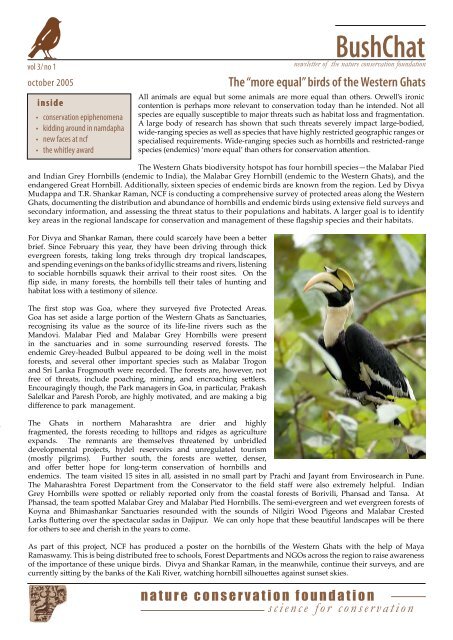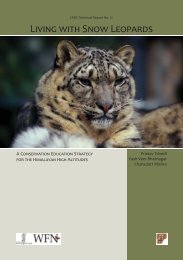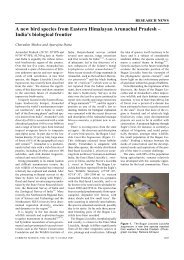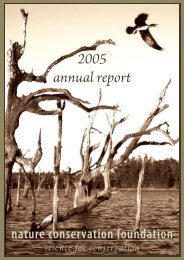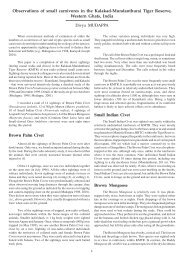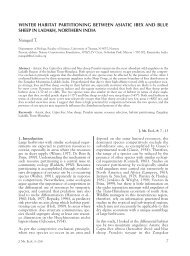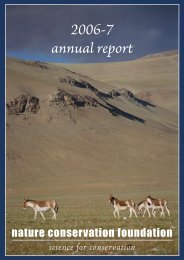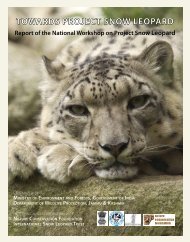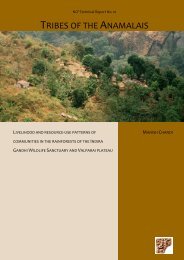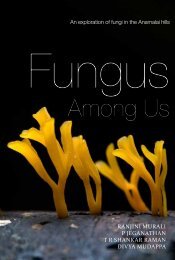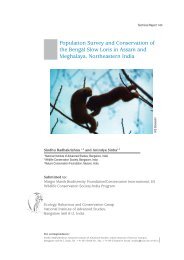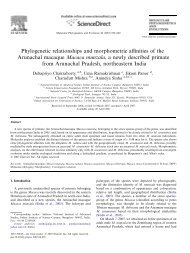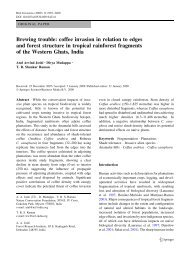BushChat - Nature Conservation Foundation
BushChat - Nature Conservation Foundation
BushChat - Nature Conservation Foundation
Create successful ePaper yourself
Turn your PDF publications into a flip-book with our unique Google optimized e-Paper software.
vol 3/ no 1<br />
october 2005<br />
inside<br />
•<br />
•<br />
•<br />
•<br />
conservation epiphenomena<br />
kidding around in namdapha<br />
new faces at ncf<br />
the whitley award<br />
All animals are equal but some animals are more equal than others. Orwell’s ironic<br />
contention is perhaps more relevant to conservation today than he intended. Not all<br />
species are equally susceptible to major threats such as habitat loss and fragmentation.<br />
A large body of research has shown that such threats severely impact large-bodied,<br />
wide-ranging species as well as species that have highly restricted geographic ranges or<br />
specialised requirements. Wide-ranging species such as hornbills and restricted-range<br />
species (endemics) ‘more equal’ than others for conservation attention.<br />
The Western Ghats biodiversity hotspot has four hornbill species—the Malabar Pied<br />
and Indian Grey Hornbills (endemic to India), the Malabar Grey Hornbill (endemic to the Western Ghats), and the<br />
endangered Great Hornbill. Additionally, sixteen species of endemic birds are known from the region. Led by Divya<br />
Mudappa and T.R. Shankar Raman, NCF is conducting a comprehensive survey of protected areas along the Western<br />
Ghats, documenting the distribution and abundance of hornbills and endemic birds using extensive field surveys and<br />
secondary information, and assessing the threat status to their populations and habitats. A larger goal is to identify<br />
key areas in the regional landscape for conservation and management of these flagship species and their habitats.<br />
For Divya and Shankar Raman, there could scarcely have been a better<br />
brief. Since February this year, they have been driving through thick<br />
evergreen forests, taking long treks through dry tropical landscapes,<br />
and spending evenings on the banks of idyllic streams and rivers, listening<br />
to sociable hornbills squawk their arrival to their roost sites. On the<br />
flip side, in many forests, the hornbills tell their tales of hunting and<br />
habitat loss with a testimony of silence.<br />
The first stop was Goa, where they surveyed five Protected Areas.<br />
Goa has set aside a large portion of the Western Ghats as Sanctuaries,<br />
recognising its value as the source of its life-line rivers such as the<br />
Mandovi. Malabar Pied and Malabar Grey Hornbills were present<br />
in the sanctuaries and in some surrounding reserved forests. The<br />
endemic Grey-headed Bulbul appeared to be doing well in the moist<br />
forests, and several other important species such as Malabar Trogon<br />
and Sri Lanka Frogmouth were recorded. The forests are, however, not<br />
free of threats, include poaching, mining, and encroaching settlers.<br />
Encouragingly though, the Park managers in Goa, in particular, Prakash<br />
Salelkar and Paresh Porob, are highly motivated, and are making a big<br />
difference to park management.<br />
<strong>BushChat</strong><br />
newsletter of the nature conservation foundation<br />
The “more equal” birds of the Western Ghats<br />
The Ghats in northern Maharashtra are drier and highly<br />
fragmented, the forests receding to hilltops and ridges as agriculture<br />
expands. The remnants are themselves threatened by unbridled<br />
developmental projects, hydel reservoirs and unregulated tourism<br />
(mostly pilgrims). Further south, the forests are wetter, denser,<br />
and offer better hope for long-term conservation of hornbills and<br />
endemics. The team visited 15 sites in all, assisted in no small part by Prachi and Jayant from Envirosearch in Pune.<br />
The Maharashtra Forest Department from the Conservator to the field staff were also extremely helpful. Indian<br />
Grey Hornbills were spotted or reliably reported only from the coastal forests of Borivili, Phansad and Tansa. At<br />
Phansad, the team spotted Malabar Grey and Malabar Pied Hornbills. The semi-evergreen and wet evergreen forests of<br />
Koyna and Bhimashankar Sanctuaries resounded with the sounds of Nilgiri Wood Pigeons and Malabar Crested<br />
Larks fluttering over the spectacular sadas in Dajipur. We can only hope that these beautiful landscapes will be there<br />
for others to see and cherish in the years to come.<br />
As part of this project, NCF has produced a poster on the hornbills of the Western Ghats with the help of Maya<br />
Ramaswamy. This is being distributed free to schools, Forest Departments and NGOs across the region to raise awareness<br />
of the importance of these unique birds. Divya and Shankar Raman, in the meanwhile, continue their surveys, and are<br />
currently sitting by the banks of the Kali River, watching hornbill silhouettes against sunset skies.<br />
n a t u r e c o n s e r v a t i o n f o u n d a t i o n<br />
s c i e n c e f o r c o n s e r v a t i o n
focus<br />
of hot water phenomena and conservation epiphenomena<br />
Accidents happen. With hindsight, it is sometimes possible to trace the complex thread of circumstances that connect<br />
the fight with the wife to the carnage on the tracks, but, of course, we do not always have the benefit of hindsight<br />
when planning our road trips. As conservation biologists we encounter ecological accidents all the time, and, for the<br />
most part, the end results are tragic. So when, on rare occasion, we see an accident with not so tragic results, it causes<br />
us to sit up and take notice. NCF has been documenting just such a fortunate accident of conservation in the coral reefs of<br />
the Lakshadweep Islands.<br />
Unusual ocean warming events that result from climate change<br />
belong to those inevitable accidents that marine biologists have<br />
come to expect as the most significant forces impacting shallow<br />
ecosystems. The El Niño of 1998 was unprecedented in the intensity<br />
and duration of unusual hot water conditions, and it left the coral<br />
reefs of the tropics much poorer for its passage. We went to the<br />
Lakshadweep reefs a few months after these anomalous ocean<br />
temperatures expecting the worst. It was worse than we expected.<br />
More than 95% of the live coral on many reefs had died, and<br />
many species of fish, directly dependent on coral had declined<br />
considerably.<br />
In hot water, corals bleach white and are rapidly taken over by algae<br />
It is often easy to predict the sequence of events after a major death of<br />
coral. We have seen it many times before, particularly in reefs that support high human densities. With coral no longer<br />
dominant, fleshy macroalgae find it easy to settle, grow and outcompete any new coral attempting to re-establish in the area.<br />
In many reefs where this has been documented, the process is difficult to reverse, and coral may not regain dominance<br />
for several decades, despite our best conservation and management efforts. The key are the herbivores. Herbivorous<br />
fish and invertebrates tip the scales in favour of coral in a healthy reef, munching down macroalgae and allowing<br />
coral to gain the upper hand in the competition for space and light. In a heavily fished reef however, herbivore<br />
numbers often decline, and can no longer control the proliferation of macroalgae, particularly after a coral mortality.<br />
This was our worst fear for the Lakshadweep.<br />
We have been tracking the impact of the El Niño to benthic and fish communities of the Lakshadweep from 1998. Thus<br />
far, the shift in dominance to macroalgae has not occurred. Quite the reverse. At many reef sites, coral are recruiting,<br />
surviving, and growing rapidly to dominance at truly encouraging rates. Herbivores are everywhere. Swarming hordes<br />
of them. Wandering from patch to patch, grazing every bit of algae growing on the substrate. At first sight, this is surprising.<br />
The Lakshadweep Islands are among the most heavily populated parts of rural India, with more than 2000 people/km 2 .<br />
And the population relies primarily on the sea for its protein. Fish supports the diet and economy of the Lakshadweepan.<br />
So why are the reefs of the Lakshadweep so apparently resilient, even in the face of such catastrophic mortality?<br />
At least part of the answer lies in history. Before the 1960s, the Lakshadweep fisherman fished for the daily meal in<br />
the seagrass beds and the reef from the shore or from small traditional boats. They caught as much as they needed for<br />
themselves and whatever was not needed, was bartered for rice with neighbours and others in the village. This was<br />
the state of affairs when the Fisheries Department<br />
of India surveyed the exploitation potential of the<br />
fishery in the Lakshadweep and concluded that here<br />
was a vast untapped resource, that the Lakshadweep<br />
fishermen were doing an inadequate job of utilising.<br />
They were not looking at the reef though. They<br />
were looking at the open ocean outside the reef.<br />
In particular, tuna fish. With almost missionary<br />
zeal, a management programme was put into<br />
place to educate Lakshadweep fishermen to catch<br />
tuna, using a pole-and-line technique. Within a<br />
few decades, this was the main fishing activity in<br />
the Lakshadweep, significantly deflecting fishery<br />
away from the reef. Today, tuna is by far the most<br />
important source of income for the islands, and<br />
has largely replaced the diversity of reef fish in the<br />
primary diet of the islands. The consequence for the<br />
reef is that it is relatively underexploited, despite<br />
the high human populations living nearby.<br />
Fishing for bait: the tuna fishery may have contributed to the high resilience of Lakshadweep reefs<br />
2
The moral is a complex one to read. On the face of it, the Lakshadweep is a success story. A reef where resilience is<br />
maintained because of a well-managed fishery. However, the reasons for the establishment of the tuna fishery had<br />
nothing whatsoever to do with reef management and everything to do with the maximisation of an underutilised<br />
resource. The conservation benefits that accrued to the reef were purely accidental, a bi-product of a developmental<br />
initiative several decades ago. These accidents don’t happen often, and we suspect, we cannot engineer them if we<br />
tried. But there are important lessons to be learnt here. Even though the conservation benefits of tuna fishing to the<br />
reef are merely ‘epiphenomenal’, they have been perhaps more successful in conserving ecosystem values than if a<br />
more standard management programme were to be started here, establishing no-take areas, and excluding people from<br />
the reef. Given a choice between immediate economic gain and intangible long-term benefit, it is quite clear what<br />
people will choose. Accidents will continue to happen. We can only hope that when these accidents<br />
present themselves as opportunities, we will recognize them, and make the best use of them for conservation.<br />
kidding around: conservation education in namdapha news<br />
How do you communicate a message of conservation to people for whom hunting is a way of life? Biologists and indigenous<br />
communities value wild species with rather different currencies. Finding a philosophical middle ground between<br />
preservation and utility is often the biggest obstacle to effective conservation. In Northeast India, NCF is attempting<br />
to tackle the problem, with a range of initiatives in and around Namdapha National Park. Not least among these is a<br />
conservation education program in Miao, the main township near the park where most wild meat is sold. We hope to<br />
eventually reach adult wild meat buyers with this program, but we started with an easier and more fun group - school<br />
children from tribal and non-tribal backgrounds. This program is being conducted with the help of SEACOW (Society for<br />
Environmental Awareness and <strong>Conservation</strong> of Wildlife),<br />
a local NGO in Miao started by Phupla Singpho and<br />
other Singpho youth.<br />
We started with a private primary school in Miao, 30<br />
children between seven and 10 years turned up for a<br />
day-long program we conducted in April. If we had<br />
space to accommodate them, the teachers assured us,<br />
there would have been many more. We used a series<br />
of role-playing games to explore basic ecological<br />
concepts with the kids. For instance, a game of catch<br />
was transformed into an elementary lesson on trophic<br />
dynamics: wearing animal masks the kids formed simple<br />
food chains (leopard-gibbon-fruit, snake-toad-butterflyflower)<br />
and the higher trophic levels had to chase down<br />
their own ‘food’. A visit to the zoo in Miao caused<br />
much excitement, and a barrage of curious questioning<br />
followed after the children learnt that the animals in this<br />
zoo were all present in the nearby forests.<br />
Playing their parts: children in Miao learning about food webs the fun way<br />
Even here in Miao, there is a noticeable difference in the<br />
levels of ecological awareness and attitudes between tribal and non-tribal children. While most of the children were aware<br />
that some of these wild animals were hunted, the non-tribal kids expressed horror and disbelief that their tribal classmates<br />
had eaten and enjoyed wild meat. When asked to draw their favourite animals, most children painted the usual peacocks<br />
and elephants, while a Lisu boy painted a leopard cat. He, along with a Singpho child, were gifted Aparajita’s lively book<br />
on Indian rainforests, Walk the Rainforest with Niwupah, as a prize for their creativity.<br />
Later, we interacted with older tribal youth from the Government Secondary School (Classes 6 to 9). They frequently went<br />
to the forest, and admitted to killing birds for sport with their catapults. Their knowledge of hornbills and the forest in<br />
general was remarkable, and several of them had seen hornbills in the nearby forests. Despite Namdapha being in their<br />
backyard, none of the boys had been there. No one thought there were any tigers in Namdapha. Most knew that tigers<br />
were hunted for their skins.<br />
The older tribal children we interacted with had a depth of first-hand knowledge (seldom seen among urban kids) and<br />
curiosity about the forest that was engaging. <strong>Conservation</strong> education here would have to keep in mind that it is vital to<br />
keep this instinctive appreciation of nature intact, while fostering an appreciation for its intrinsic values and its potential<br />
finiteness. This, hopefully, will lead to voluntary changes in their behavior, without the need to lecture them with sermons<br />
based on rather alien notions that eating wild meat or killing birds with catapults is ‘bad’.<br />
3<br />
focus
ambika aiyadurai<br />
charudutt mishra awarded the whitley gold<br />
Feel free to contact us for more<br />
information on our work and for<br />
details on the full range of our<br />
activities.<br />
We are at<br />
3076/5 IV Cross Gokulam Park<br />
Mysore 570002 INDIA<br />
Phone + 91 . 821 . 251 5601<br />
Fax + 91. 821 . 251 3822<br />
ncf@ncf-india.org<br />
www.ncf-india.org<br />
TO<br />
n a t u r e c o n s e r v a t i o n f o u n d a t i o n<br />
s c i e n c e f o r c o n s e r v a t i o n<br />
4<br />
new faces at ncf<br />
After my graduation in Zoology from Saurashtra University, Gujarat, I spent three years in Centre for Environment<br />
Education, Ahmedabad where my job was to develop communication materials specifically for teachers and students. I<br />
quit the job to do an M.Sc (Wildlife Science) from Wildlife Institute of India, Dehradun. For my Master’s thesis, I carried<br />
out a radio-telemetry study on Golden Jackals in Velavadar National Park (Gujarat). My visit to Arunachal Pradesh for<br />
a survey on human-animal conflict has led me to NCF to develop a PhD project on Hunting by tribal communities in<br />
Arunachal Pradesh and its implications for wildlife conservation.<br />
rakhee karumbaya<br />
Between Chikmagalur, Papua New Guinea and the Australian outback, I have spent more time in natural areas than in<br />
cities. I had an idyllic childhood with sandy beaches as my playground, dense tropical forests to trek in, and mountain<br />
rivers to swim in. My first experience of living in a city in Australia left me longing for the innocence of my time in<br />
PNG. I returned to India in 1989 to do my Bachelor’s degree in Literature and Journalism, and worked in various PR and<br />
Management positions after graduation. After marriage, my husband was offered a position in PNG, and I leapt at the<br />
opportunity to return to a place that I loved so much as a child.<br />
On the surface, nothing seemed to have changed in PNG, but the economic and political climate was in rapid transition,<br />
and country was becoming more commercial and globalised. Law and order was on the decline, and there was a growing<br />
resentment against the expat communities. After seven years in PNG, we returned to India with our two children.<br />
I have been working for the <strong>Nature</strong> <strong>Conservation</strong> <strong>Foundation</strong> since May 2005, coordinating NCF’s various projects, and<br />
attempting to bring some order to the general chaos that prevails here. I also edit the Babbler, which contains all the<br />
insider NCF gossip.<br />
In a heartening recognition of NCF’s pioneering conservation<br />
efforts in the Himalaya, the Whitley <strong>Foundation</strong> awarded the<br />
top honour to Charudutt Mishra. Often called ‘The Green Oscar’,<br />
the Whitley Award was presented to Charu by HRH Princess<br />
Royal at a packed gathering at the Royal Geographical Society<br />
in London on 20th April 2005. The award recognises more than<br />
a decade of ecological research and conservation in some of the<br />
most unforgiving environments in India. The Whitley Award<br />
comes along with a 60,000 pound grant, which will be used<br />
exclusively to increase the reach of NCF-ISLT’s high–altitude<br />
conservation programme. Congratulations Charu!<br />
Printed on Recycled Paper


